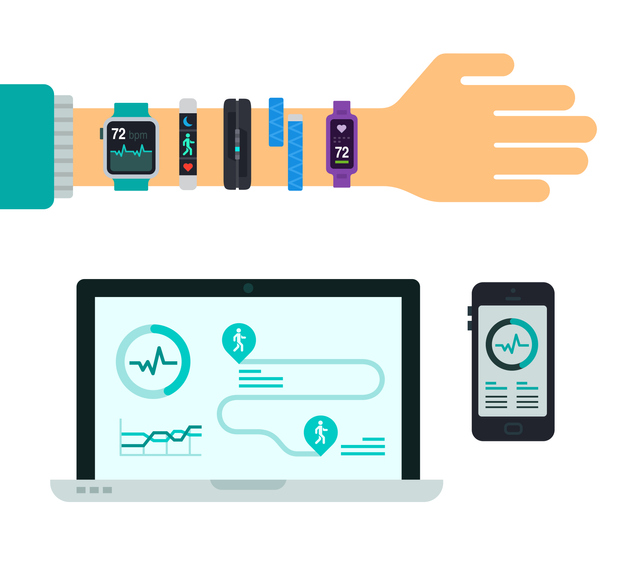Health And Fitness Trackers Are Becoming A Lot More Granular
Many people have become accustomed to devices quantifying their steps or heart rate. That’s just the beginning.
From counting 10,000 steps to reminding when to stand or take a few deep breaths, many Americans have become accustomed to devices quantifying their progress toward health goals. Is this just the beginning?
Businesses and researchers are dreaming up the next generation of methods to create and quantify personal data, with the aim of using the information to boost health and happiness. Some technologies are in their infancy, including machines that sit in the home, passively scanning for early signs of illness. Others are in limited use. Still others, such as smart thermometers and blood-glucose monitors, are widespread, but their proponents see untapped potential in the data they collect.
These advances bring concerns about security, as sensitive information is beamed up to the cloud, and privacy, especially in cases where manufacturers own data about their customers’ health that the customers themselves can’t access. It’s still too early to know exactly which metrics correspond to improved health, or whether zealously tracking them itself has negative impacts.
Natural Medicine
Research has shown that time outdoors can benefit well-being—but do certain natural settings have an outsize effect? NatureQuant, based in Bend, Ore., is aiming to quantify time in nature. This week, the company released NatureDose, an app that tracks people’s time indoors and outdoors as they go about their daily routines. The app can map the types of nature a person passes, whether a lake or tree-lined city street, through phone sensors including GPS and accelerometers. That data is paired with NatureQuant’s mapping systems to determine a person’s proximity to natural elements. The app is being tested in clinical trials in universities, with the aim of determining how time in nature impacts anxiety and depression. Eventually, the company hopes, health professionals could use the data to prescribe time in nature, even tailoring recommendations by lifestyle, season and locale. For example, the app could alert users with vitamin D deficiencies to the best time to catch UV rays.
Watch Your Mouth
Dentists have long advised brushing teeth for two minutes twice a day. In the future, quantifying dental data, such as tracking acidity in the mouth, may help forecast cavities before they happen and draw connections between oral health and other health issues. For example, night guards or other devices that measure specific biomarkers in saliva could uncover disease, such as inflammation of the gums that is linked to diabetes, says Dr. Corneliu Sima, an assistant professor of oral medicine, infection and immunity at the Harvard School of Dental Medicine. Camera-enabled toothbrushes could serve as oral scanners, beaming real-time information to dentists, who could use machine learning to sift through the data to determine whether patients need to come in for a visit, he says.
Body of Water
The well-known admonition to drink eight glasses of water a day has persuaded many Americans to lug around water bottles in the hopes of satisfying their hydration needs. Hydration, after all, has been shown to benefit brain function, heart health, digestion and other bodily functions. Is eight glasses really the right number for everybody? In the future, connected devices could help assess how much water is the optimum amount for each individual. The PÜL SmartCap, a mobile-connected water-bottle cap, recently hit the market promising to help consumers set goals and track their hydration levels with an accompanying app.
In the Blood
Some people are wearing blood-glucose monitoring devices, which continuously measure blood sugar via a small device worn on the arm, even if they don’t have diabetes. Elevated or spiking blood sugar is linked to heart disease, stroke and diabetes, so proponents of blood-glucose monitors say that tracking blood sugar could help wearers personalize their diets and live healthier lives. The Levels software, for example, allows users to watch their glucose levels on an app as they eat different foods, exercise and sleep. Ultimately, the company envisions people having several biosensor streams to help them optimize cell function and predict disease, says Dr. Casey Means, the chief medical officer of Levels.
The Wearable You Don’t Need to Wear
Researchers at the Massachusetts Institute of Technology have created a wall-mounted, laptop-size box that sits in the home, analyzing electromagnetic waves around residents as a noninvasive way of gauging health metrics. Using machine learning, the device can track breathing, heart rate, movement, gait, time in bed and the length and quality of sleep—even through walls. Health organizations, hospitals and medical schools are using the device. It is being used in clinical studies for Parkinson’s disease, Alzheimer’s and immune diseases and was used to monitor Covid-19 patients in isolation during the first wave of the pandemic. Dr. Dina Katabi, a professor at MIT’s computer science and artificial intelligence lab who led the project, says the boxes could be used in the homes of seniors and others to help detect early signs of serious medical conditions, and as an alternative to wearables.
Taking the Temperature
Thermometers are ubiquitous in households across the country. They are often the first medical tool that people consult once they start feeling sick. Aggregating those temperature readings and associated symptoms could someday quantify and diagnose illness at a population level. In the coming years, smart thermometers may be able to help determine whether patients have particular strains of flu or Covid-19, based on symptoms, temperature and other data collected in the area. Inder Singh, the founder of Kinsa, a San Francisco-based smart-thermometer company, says this kind of diagnosis could allow patients to bypass doctor visits and get medication quickly. Kinsa is working to turn its smart thermometers, introduced in 2013, into a system that detects outbreaks and tells people how and when they should seek treatment. The network has about 2.5 million thermometers in the U.S. so far.
Old Dog, New Tricks
Pet owners, including the many who adopted animals during the pandemic, are seeking to quantify the health of their furry friends as well. Whistle Fit, for example, offers a glimpse into a possible future for connected pet care. The 1.5-inch device affixes to a dog’s or cat’s collar and monitors its health, fitness and behaviour. Sensors collect data about a pet’s daily routine. Algorithms analyze the data to detect behavior tied to well-being, including playing, running, sleeping, exercising and drinking. After establishing a baseline, Whistle can determine whether a pet’s behaviour is changing. The owner can set exercise goals based on breed, age and weight. The company provides summaries to share with vets and alerts around behavioural problems like excessive licking or scratching.
The Right Amount of ZZZs
A plethora of products is already on the market to help people sleep. More futuristic offerings include robots that help lull patients to sleep with breathing exercises and “digital sleeping pills,” beamed through headbands that play music or soothing sounds when they sense users are about to wake up, says Dr. Seema Khosla, the medical director at the North Dakota Center for Sleep. Going forward, it would be helpful to have a bespoke assessment of how much sleep each individual needs, as opposed to the one-size-fits-all recommendation of eight hours, she says. Devices will likely be less clunky in the coming years, she says, sitting by the bedside with less need for physical contact with the sleeper.
Reprinted by permission of The Wall Street Journal, Copyright 2021 Dow Jones & Company. Inc. All Rights Reserved Worldwide. Original date of publication: 13th, January, 2022.
 Copyright 2020, Dow Jones & Company, Inc. All Rights Reserved Worldwide. LEARN MORE
Copyright 2020, Dow Jones & Company, Inc. All Rights Reserved Worldwide. LEARN MORE
This stylish family home combines a classic palette and finishes with a flexible floorplan
Just 55 minutes from Sydney, make this your creative getaway located in the majestic Hawkesbury region.
The remote northern island wants more visitors: ‘It’s the rumbling before the herd is coming,’ one hotel manager says
As European hot spots become overcrowded , travellers are digging deeper to find those less-populated but still brag-worthy locations. Greenland, moving up the list, is bracing for its new popularity.
Aria Varasteh has been to 69 countries, including almost all of Europe. He now wants to visit more remote places and avoid spots swarmed by tourists—starting with Greenland.
“I want a taste of something different,” said the 34-year-old founder of a consulting firm serving clients in the Washington, D.C., area.
He originally planned to go to Nuuk, the island’s capital, this fall via out-of-the-way connections, given there wasn’t a nonstop flight from the U.S. But this month United Airlines announced a nonstop, four-hour flight from Newark Liberty International Airport in New Jersey to Nuuk. The route, beginning next summer, is a first for a U.S. airline, according to Greenland tourism officials.
It marks a significant milestone in the territory’s push for more international visitors. Airlines ran flights with a combined 55,000 seats to Greenland from April to August of this year, says Jens Lauridsen, chief executive officer of Greenland Airports. That figure will nearly double next year in the same period, he says, to about 105,000 seats.
The possible coming surge of travellers also presents a challenge for a vast island of 56,000 people as nearby destinations from Iceland to Spain grapple with the consequences of over tourism.
Greenlandic officials say they have watched closely and made deliberate efforts to slowly scale up their plans for visitors. An investment north of $700 million will yield three new airports, the first of which will open next month in Nuuk.
“It’s the rumbling before the herd is coming,” says Mads Mitchell, general manager of Hotel Nordbo, a 67-room property in Nuuk. The owner of his property is considering adding 50 more rooms to meet demand in the coming years.
Mitchell has recently met with travel agents from Brooklyn, N.Y., South Korea and China. He says he welcomes new tourists, but fears tourism will grow too quickly.
“Like in Barcelona, you get tired of tourists, because it’s too much and it pushes out the locals, that is my concern,” he says. “So it’s finding this balance of like showing the love for Greenland and showing the amazing possibilities, but not getting too much too fast.”
Greenland’s buildup
Greenland is an autonomous territory of Denmark more than three times the size of Texas. Tourists travel by boat or small aircraft when venturing to different regions—virtually no roads connect towns or settlements.
Greenland decided to invest in airport infrastructure in 2018 as part of an effort to expand tourism and its role in the economy, which is largely dependent on fishing and subsidies from Denmark. In the coming years, airports in Ilulissat and Qaqortoq, areas known for their scenic fjords, will open.
One narrow-body flight, like what United plans, will generate $200,000 in spending, including hotels, tours and other purchases, Lauridsen says. He calls it a “very significant economic impact.”
In 2023, foreign tourism brought a total of over $270 million to Greenland’s economy, according to Visit Greenland, the tourism and marketing arm owned by the government. Expedition cruises visit the territory, as well as adventure tours.
United will fly twice weekly to Nuuk on its 737 MAX 8, which will seat 166 passengers, starting in June .
“We look for new destinations, we look for hot destinations and destinations, most importantly, we can make money in,” Andrew Nocella , United’s chief commercial officer, said in the company’s earnings call earlier in October.
On the runway
Greenland has looked to nearby Iceland to learn from its experiences with tourism, says Air Greenland Group CEO Jacob Nitter Sørensen. Tiny Iceland still has about seven times the population of its western neighbour.
Nuuk’s new airport will become the new trans-Atlantic hub for Air Greenland, the national carrier. It flies to 14 airports and 46 heliports across the territory.
“Of course, there are discussions about avoiding mass tourism. But right now, I think there is a natural limit in terms of the receiving capacity,” Nitter says.
Air Greenland doesn’t fly nonstop from the U.S. because there isn’t currently enough space to accommodate all travellers in hotels, Nitter says. Air Greenland is building a new hotel in Ilulissat to increase capacity when the airport opens.
Nuuk has just over 550 hotel rooms, according to government documents. A tourism analysis published by Visit Greenland predicts there could be a shortage in rooms beginning in 2027. Most U.S. visitors will stay four to 10 nights, according to traveler sentiment data from Visit Greenland.
As travel picks up, visitors should expect more changes. Officials expect to pass new legislation that would further regulate tourism in time for the 2025 season. Rules on zoning would give local communities the power to limit tourism when needed, says Naaja H. Nathanielsen, minister for business, trade, raw materials, justice and gender equality.
Areas in a so-called red zone would ban tour operators. In northern Greenland, traditional hunting takes place at certain times of year and requires silence, which doesn’t work with cruise ships coming in, Nathanielsen says.
Part of the proposal would require tour operators to be locally based to ensure they pay taxes in Greenland and so that tourists receive local knowledge of the culture. Nathanielsen also plans to introduce a proposal to govern cruise tourism to ensure more travelers stay and eat locally, rather than just walk around for a few hours and grab a cup of coffee, she says.
Public sentiment has remained in favour of tourism as visitor arrivals have increased, Nathanielsen says.
—Roshan Fernandez contributed to this article.
This stylish family home combines a classic palette and finishes with a flexible floorplan
Just 55 minutes from Sydney, make this your creative getaway located in the majestic Hawkesbury region.






















